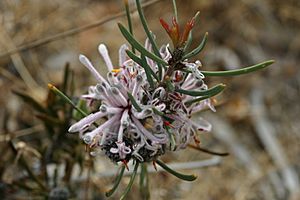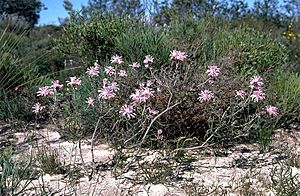Pixie mops facts for kids
Quick facts for kids Pixie mops |
|
|---|---|
 |
|
| Scientific classification | |
| Genus: |
Petrophile
|
| Species: |
linearis
|
| Synonyms | |
|
|
The Petrophile linearis, often called pixie mops, is a pretty flowering plant. It belongs to the Proteaceae family, which includes many unique Australian plants. You can only find this shrub in the southwestern part of Western Australia. It has long, narrow leaves and produces fluffy, round flower heads that look like little mops! These flowers can be greyish-pink, purple, or almost white.
Contents
What Pixie Mops Look Like
Pixie mops are shrubs that usually grow to be about 0.5 to 1 meter (about 1.5 to 3 feet) tall. Their branches and leaves are smooth, meaning they don't have any hairs. The leaves are shaped like a narrow egg, with the thinner end at the bottom. They are usually curved and can be 50 to 120 millimeters (about 2 to 4.7 inches) long and 1.5 to 10 millimeters (about 0.06 to 0.4 inches) wide.
The flowers grow in oval or round heads, up to 25 millimeters (about 1 inch) wide. These flower heads are found at the ends of branches or where leaves meet the stem. Many small, pointed leaves called involucral bracts surround the base of the flower heads. Each flower is about 35 millimeters (about 1.4 inches) long and feels hairy. They come in shades of greyish-pink, mauve (light purple), or almost white.
Pixie mops typically bloom from August to November. After flowering, they produce a type of fruit called a nut. These nuts are joined together in an oval head, which is about 25 millimeters (about 1 inch) long.
How Pixie Mops Got Their Name
The scientific name Petrophile linearis was first officially described in 1830. This was done by a famous botanist named Robert Brown. He wrote about it in a special book called the Supplementum. The plant samples were collected by Charles Fraser near the Swan River in 1826.
The second part of the plant's scientific name, linearis, describes its leaves. "Linearis" means "linear" or "narrow," which perfectly fits the long, thin leaves of the pixie mops.
Where Pixie Mops Live
Pixie mops like to grow in woodlands and open heath areas. You can find them on the coastal plains and in the Darling Range in Western Australia. Their natural home stretches from places like Jurien Bay and Eneabba down to Yallingup.
Keeping Pixie Mops Safe
The Western Australian Government's Department of Parks and Wildlife keeps an eye on plants like the pixie mops. They have officially classified this plant as "not threatened." This means that, for now, there are enough pixie mops in the wild, and they are not in danger of disappearing.


